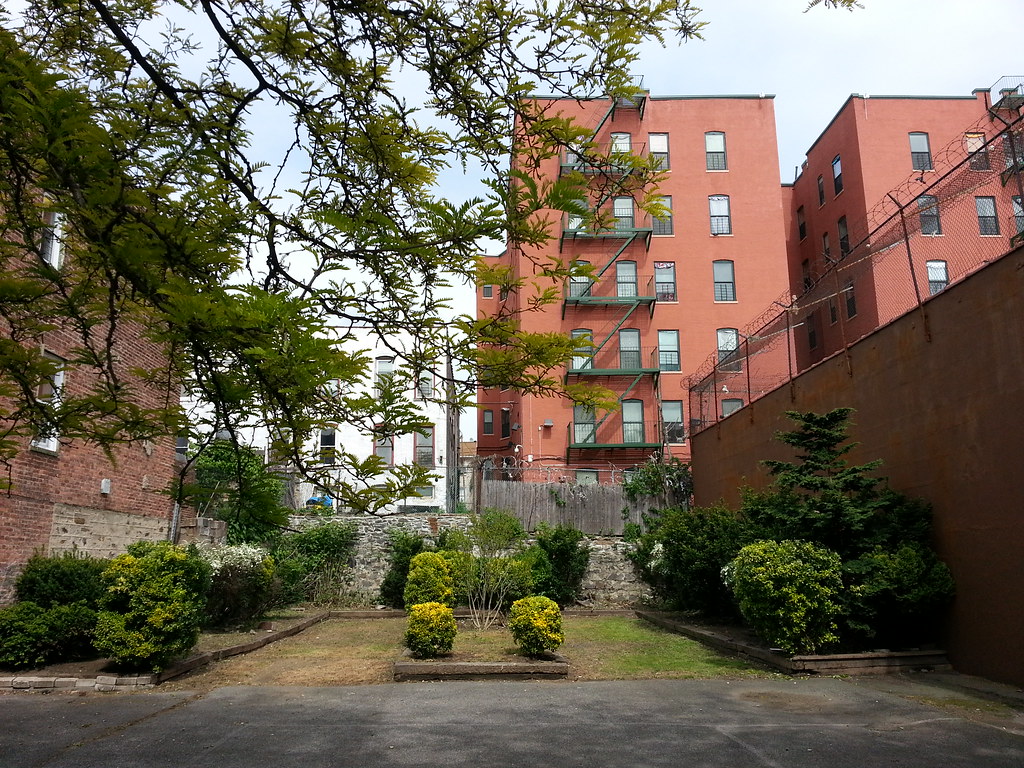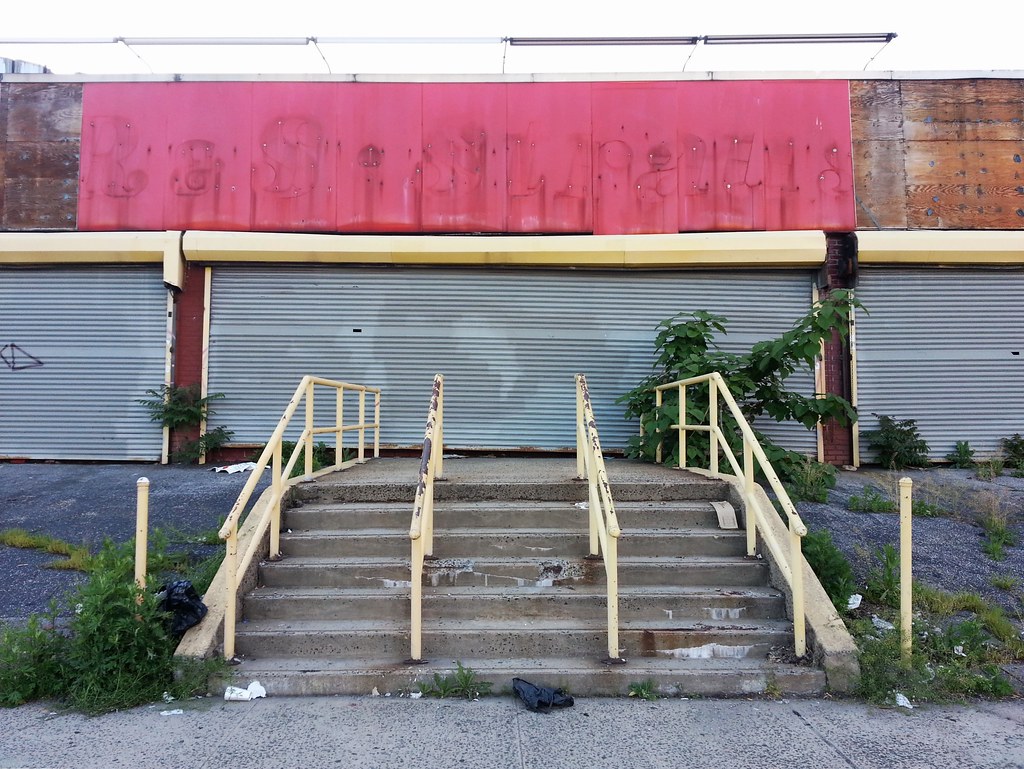

Located in the enormous Hunts Point Food Distribution Center, this is the self-proclaimed largest wholesale produce market in the world. Here's a great peek inside the market by two brothers from South Carolina who, when they were new to the city and looking to make their Lower East Side apartment feel a little more homey, set out for Hunts Point in search of raw peanuts to boil.
Welcome to the Hunts Point Living Memorial Trail!
This memorial was created by Greening for Breathing, a local association dedicated to improving air quality, health, and well-being in Hunts Point through tree planting, tree care, and community building.
The Trail is part of the Living Memorials Project, which uses the resonating power of trees to bring people together and to create memorials to the victims of September 11, their families, communities, and the nation.
This Trail was designed and is maintained by community members that have an ongoing commitment to the preservation of this special place. This group first came together in the fall of 2004 to pay tribute to the past, present, and future heroes of the neighborhood. The tree species were chosen so that there is something beautiful to observe during all four seasons, the tree guards curve in order to evoke the feeling of a path, and the qualities by each tree describe a true Hunts Point hero.
The trees help fight air pollution and asthma, and form a connection to the park and the South Bronx Greenway, enabling more community members to visit and enjoy the healing power that trees and open green space provides. Please do your part to keep the trees healthy and beautiful by keeping dogs and garbage away.
Enjoy the beauty of the trees, learn more about them, and think about the heroes in your life and the ways that you, too, are a hero. Come alone or with friends and family. Talk about how you can support your community. Walk or bicycle. Relieve stress. Explore. Be inspired!

Originally known as Tiffany Plaza when it was dedicated in 1981, this strange little parklet comprises the dried-up leonine fountains you see above, as well as an adjacent wooded plot containing a couple of dozen honey locust trees. (You can take a look around in Street View.) Judging by some old photos, the area was once fully open to the public, but the fountains and most of the trees are now enclosed by fences and locked gates. The photos also show a raised speaker's platform located in front of the fountains. It was apparently intended to be used for "civic and religious events", but was removed sometime during the intervening years.
The man for whom the plaza was renamed, Father Louis Gigante (or Father G., as he is often called), is a priest sprung from a family of mobsters. It's hard to believe Martin Scorsese hasn't made a film about him, although the two are apparently friends. According to the NYPD, three of Father G.'s brothers were Mafiosi, most notably Vincent "The Chin" Gigante, the former boss of the Genovese crime family, who was famously known for his decades of publicly feigning insanity. As the NY Times reported in his 2005 obituary:
For Mr. Gigante, the guise that he adopted in the mid-1960's — behavior that won him the nickname Oddfather — took considerable effort to maintain. He could often be seen shuffling around his Greenwich Village neighborhood in pajamas, bathrobe and slippers, mumbling to himself and appearing to be a disturbed but harmless person. Law-enforcement agents, prosecutors and Mafia defectors described his behavior as a staged performance calculated to evade prosecution for his activities as head of a crime family that under his leadership became the wealthiest and most powerful in the nation.His elaborate ruse was successful in delaying his prosecution for years, and he managed to convince "some of the most respected minds in forensic psychiatry and neuropsychology" that he was mentally incompetent, but he was eventually put on trial anyway, and was convicted of racketeering and murder conspiracy in 1997. Letting his guard down in prison, he was recorded having numerous normal-sounding phone conversations with friends and family. This finally led him to admit in court in 2003, after all those years, that the whole thing had been an act.
But let's get back to Father G. He served for four decades as a priest at St. Athanasius Church (also the longtime home of the "legendary" Sister Thomas), which stands just across the street from the plaza that bears his name, but he is best known for his work outside the church. As the founder of SEBCO, the Southeast Bronx Community Organization, he has been highly lauded for the significant role he played in rebuilding Longwood and Hunts Point, the once-ravaged neighborhoods that surround his church, with SEBCO developing some 5000 units of low- and moderate-income housing in the area.
Despite his heavenly calling and his work in the community, however, Father G. is no stranger to controversy. There's been innuendo and speculation over the years about his possible connections to the Mafia — not surprising, given his family ties — although he's never been formally accused of any wrongdoing. He did, however, spend a week in jail in 1979 when he "refused to answer grand jury questions about his efforts to have Corrections Department officials ease the rigors of prison life for James Napoli, whom the authorities called a gangster." He also helped further his mob boss brother's attempted deception of the authorities, fighting (unsuccessfully) to have Vincent declared mentally unfit to stand trial. (Father G. has insisted that the Mafia is just "a creation of the media", and that Vincent was a "gentle man", a "just man", and a "man of God".)
For years and years, he received universal acclaim for creating "a concrete and brick miracle in a neighborhood that was legendary for the resoluteness of its death march", but some of that luster has now begun to fade. In 2007, the Village Voice ran an article calling him a "slumlord" for allowing living conditions in some of his buildings to deteriorate drastically while he continued to pull in a $150,000 salary from his various community enterprises. Regarding the wealth he has acquired, Father G. makes no apologies. "I didn't take a vow of poverty", he was quoted as saying, with characteristic brashness, in a 1981 NY Times article. "People think I don't get paid and that I'm a saint for doing it. That's their problem." After all, "If I weren't here, it would be all devastation . . . If I want to kiss myself or something, I'll kiss myself."

From a previous post:
Completed in 1911, the American Bank Note Company Printing Plant produced "stock certificates, foreign currency, letters of credit, postage stamps and, of course, bank notes" for governments all over the world. The company left town for the Philadelphia suburbs in 1985, and the building has been home to many different tenants since then. It is currently being redeveloped into a higher-profile space for creative firms and nonprofit organizations.

This Jesuit middle school in Hunts Point provides tuition-free education to its students, all of whom come from financially struggling families; parents just have to pay a $75 monthly fee per student. The school has fallen deep into debt, however, and may have to close soon.

I assumed this sign was pointing the way to two distinct places that seemed funny when juxtaposed — a children's recreation area and a waste disposal facility — but it turns out that Kids Waterfront Corp. is simply the name of a company that runs a waste transfer station. ("DUMP" appears to be a relatively new addition to the sign, FYI.)

The authorities seem to be a bit in the dark regarding this little green space. According to a sign posted on the fence:
Barretto Park . . . recalls the rustic atmosphere that once characterized Hunts Point. A red picket fence rambles from end to end of the grassy parcel and a wooden shed painted in bright colors stands in the center. A wrought iron trellis and a small gazebo contribute to the country flavor.The Barretto Park page on the Parks Department's website only adds to the confusion, its photo collection filled with shots of the area that has now become the similarly named but quite distinct Barretto Point Park, a much newer and larger park located half a mile away on the waterfront (and home to the 100,000-gallon Floating Pool Lady).

It's not too unusual to find Belgian blocks clawing their way up through the asphalt in New York, but this set of setts is arranged in a particularly striking pattern.

Dedicated to the same man as, and located just down the block from, #125

Adjacent to the old Port Morris branch, this former "snow-white temple of bread-making cleanliness" was built by the Ward Baking Company, and, according to Aaron Bobrow-Strain,
along with its twin in [Brooklyn], was the flagship of a revolution in the way the country's single most important staple was produced and sold. . . . At the company's height, Ward's Brooklyn and Bronx factories supplied one in every five bakery loaves eaten in New York City. By the end of the 1920s, the company had extended that power across the entire country, coming astoundingly close to achieving monopoly control over every single sizable bread market in the nation.Robert and George Ward, brothers and founders of the company, also owned the Brooklyn Tip-Tops (named after Ward's Tip-Top brand of bread), a baseball team in the short-lived Federal League. The Tip-Tops played at Washington Park in Gowanus, previously home to Brooklyn's National League club (the team now known as the Dodgers), in a new stadium built for their inaugural season of 1914. While the stadium has almost entirely vanished at this point, there is still one remaining section of wall, which we saw last year on 3rd Avenue.
(Thanks to Gary Fonville for identifying this building for me.)

This remote-looking outpost on the 6 train is, by a wide margin, the Bronx's least-used subway station, with only 285,464 riders entering here in 2012, compared to 524,988 at Whitlock Avenue, the borough's second-most lonely stop. Citywide, only a handful of stations on the Rockaway Line (which is finally back up and running in its entirety, seven months after getting pounded by Hurricane Sandy) had fewer passengers last year. If you're interested, you can see annual ridership numbers for each subway station here.

If you've ever taken Amtrak between New York and Boston, you've passed right by this spot. The two tracks to the right, at the edge of the Oak Point Yard, are part of the Northeast Corridor, America's busiest passenger rail line. Note the overhead catenary wires that provide electricity to the trains using those tracks.

I've previously seen a group of gentlemen, who looked like regulars, hanging out during the day in this weird piece of no man's land — a small, mostly fenced-in area lying between Spofford Avenue and a locked gate of the once-notorious Spofford Juvenile Center (later renamed Bridges Juvenile Justice Center), which closed in 2011. It doesn't seem like much, but this little spot offers all you really need: a relatively quiet place to sit in the shade of a large tree (not to mention the tiny tree that appears to be bent directly over the table and chairs).















